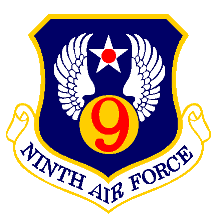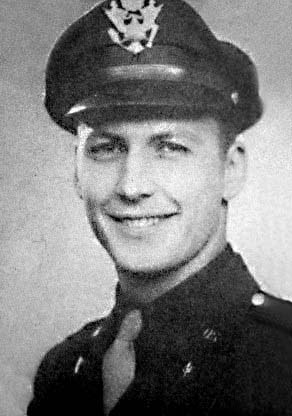1944-04-15
North American P-51B-1-NA Mustang - Serial # 43-12126
USAAF 354 FG, 355 FS, Boxted, Stn 150
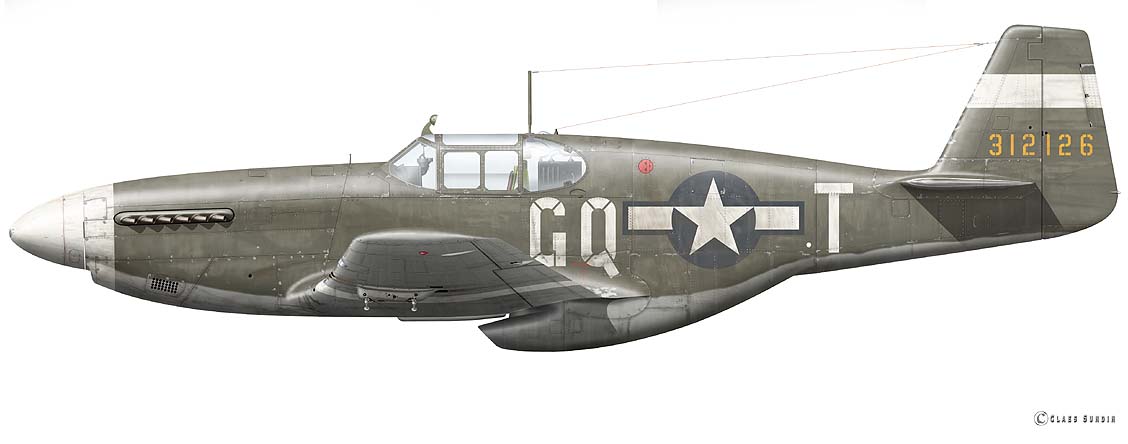
Color Profile by Claes Sundin
- 2/Lt E.E. Phillips, Pilot
Force landed Mustangs:
"The Skummeslöv-Mustang"
- Text by Jarl Svensson -
This is the story of a pilot and his aircraft:
Historical background
The spring of 1944 was a dramatic time in Europe, the Second World War had been raging for more than four years. For Germany the war was no longer the great success it once was. On the Russian Front the German army suffered heavy losses and in France they waited for the Allied invasion. North Africa had Germans and Italians had to to give up already the year before and in Italy Allied forces slowly advanced northward. Moreover, the war had come home to the German people. Since a few years back, Allied bombers had increasingly dropped their deadly loads on both industrial and military installations as well as civilian housing. The British bombers came by night and the American by day.
|
When the U.S. was drawn into the war by the events of Pearl Harbor it was determined that the fight against Nazi Germany had the highest priority. U.S. personnel arrived in England, in particular, to construct airfields. In East Anglia lots of fields were built that would be used by the USAAF 8th Air Force, "The Mighty Eight", who operated the heavy four-engined bombers. But also the recently founded 9th Air Force was established on the bases in southeast England. While the 8th AF had strategic tasks the 9th AF had a tactical focus using medium bombers and fighters. During 1943 the forces had been built up so that they could orchestrate bombing raids with 1000 bombers. RAF preferably bombed by night since it was considered safer for the flight crews. The difficulty was instead to hit the targets with precision. |
|
The Americans' philosophy was to conduct precision bombing during daylight using 4-engined B-17 Flying Fortress´ and B-24 Liberator´s. They had a crew of 10 and was heavily armed with .50cal. Browning machineguns directed in all directions from the aircraft. The intention was that the bombers could operate deep into enemy territory without fighter escort. They could defend themselves against enemy fighters by flying in tight formations, "boxes". This defense proved to be not as effective as intended, the bombers still needed fighter escort. The aircraft available at this time, Supermarine Spitfire, Republic P-47 Thunderbolt and Lockheed P-38 Lightning, did not have the sufficient range to follow the bombers to targets deep inside Germany and back. In the autumn of 1943 attacks against particular industries in Schweinfurt and Regensburg were carried out with devastating losses. The whole bombing campaign risked being wrecked without the protection of fighter escort.
The Aircraft
When Britain declared war on Germany in 1939 it was understood that available munitions would not be enough for a long war. The close contact with the United States led to large quantities of military equipment being ordered there. Among other things, the British wanted fighters such as the Curtiss P-40 to be manufactured by North American plants in California. But there was a proposal for a more modern aircraft that was offered to the British, who were interested, and in record time the prototype NA-73X took to the air.
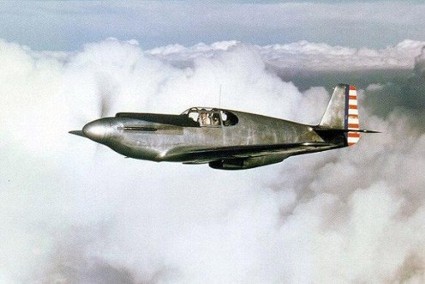
The aircraft was a single-engine, single-seat fighter with a liquid-cooled Allison V-12 engine as powerplant. It was an ultra-modern aircraft with a thin wing that gave low drag at high speed and long range. Even before the first test flight in October 1940, the British ordered 320 machines of the aircraft that the RAF later chose to name the Mustang. The first production models came to England in the autumn of 1941. They were used in battle for the first time during the summer of 1942. Even USAAF realized that this was a fantastic aircraft. One drawback was that the Allison engine that was powerful at lower altitudes quickly became impotent at higher altitudes. It was therefore given other combat tasks than that of a fighter. On both sides of the Atlantic it was understood what the solution was. The Spitfire was fitted with a Rolls Royce Merlin engine and it would fit well in the Mustang. In the autumn of 1942 engine replacement and several other improvements had been completed and in 1943 the Mustang III or P-51B, as the USAAF called it, entered production.
The Prototype NA-73X in the air
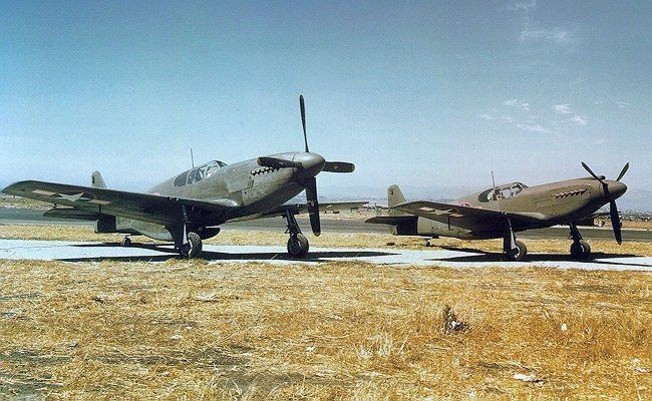
To the left a P-51B with Merlin engine and to the right the earlier P-51 with Allison engine. The differences in engine cowlings and propellers can clearly be seen. The later model P-51D was modified with a lowered back and a bubble hood for better all-round view.
The first aircraft arrived in England in the fall and they were very anticipated by the bomber-crews. Using disposable extra fuel tanks under the wings the new fighters could escort their "Big friends" to Berlin and back to England again. The plane that came to crash in Skummeslöv is an early sub-variant of the P-51B. As we understand it should be no.34 in the first production series (43-12093-12492). 43-12126 was delivered to the RAF and got the serial FX851, allegedly the aircraft was used for performance evaluation and test with alternate equipment. On December 30, 1943 the aircraft was transferred to the USAAF and given the code letters GQ-T when used by the 355th FS.
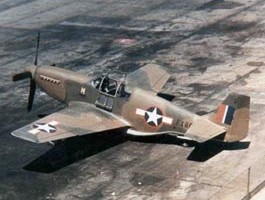
A fresh out of the factory P-51B, take note of the British camouflage and the mix of American and British national insignias. The machine is FX8?? and thus from the same batch (FX848-999) as the Skummeslöv-Mustang.
354th Fighter Group at Boxted
Norteast of London, in East Anglia, an air base was built in 1942-43 just outside the town of Colchester. The base, station 150, came to be called Boxted. The first who used the airport was 386th Bombardment Group with their twin-engined B-26 Marauder bombers. There were three intersecting runways in a triangle, the standard layout for the USAAF at this time. The tracks were covered with cement and between 1200 meters and 2000 meters long. In October 1943 the 386th BG moved out and in came the 9th Air Force, with the 354th Fighter Group.
The group consisted of three Fighter Squadrons, 353rd, 355th and 356th, each FS consisted of about 20 aircraft. In November 1943 the new P-51B and their pilots arrived at Boxted. The aircraft was not intended to be used to escort bombers, but as "The Mighty Eight" so badly needed fighter escort for their bombers the 354th was set up until the 8th Air Force had built up their own fighter units. The 354th took part in the battles over Europe as early as on the first of December. A "fighter sweep" was conducted against targets on the continent and on December 5, the first escort mission was flown to Amiens in northern France. Ten combat mission were flown in December, 1944 came and the escort duties continued as well as a few "fighter sweeps". In time the assignments became longer and on March 4 the first of many missions to Berlin was staged. Already from the beginning the group proved its effectiveness and came to be the most successful Allied fighter unit in Europe. On April 15 the 354th was to fly their last mission from Boxted. A mission that would be fateful for three of the pilots. On the 17th, a monday, it was time to move to Lashenden in Kent to prepare for their duties in the imminent invasion of mainland Europe. The 354th was intended as a forwardly advanced unit and became one of the first to move to France after the invasion.
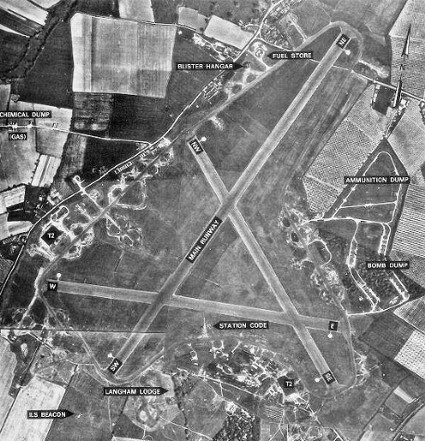
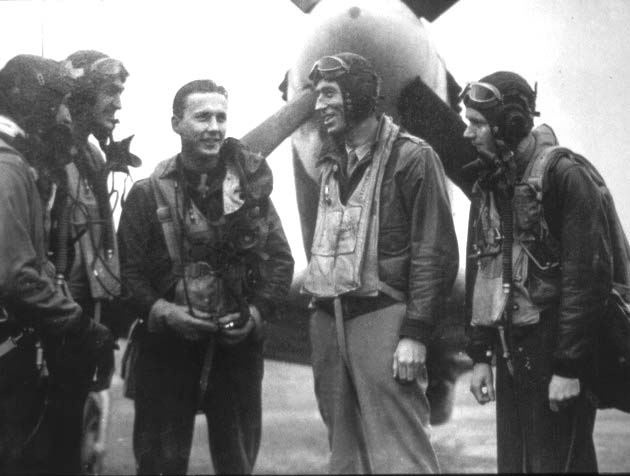
Edward E. Phillips (third from left) along with other pilots from the 355th FS. Photo via Jarl Svensson
The mission on April 15th, 1944
It is Saturday morning at the air base, pilots from the 354th has begun to prepare for today´s mission. Breakfast and briefing of today´s mission. The order speaks of a "fighter sweeps" - a fairly free-hunting mission over enemy airspace in order to attack any worthwhile target that can be found and hopefully to engage enemy fighters. It is vital to hinder the German war effort as much as possible, because in a month the "Festung Europa" is to be invaded. Target of the day is the area around Rostock and Rügen. There are several interesting targets, especially aircraft and missile testing facilities. Peenemünde is located nearby.
The planes are serviced, drop tanks are installed and fuelled. Each Mustang carries four .50cal Browning machineguns, ammunition is loaded in trays in the wings. Radio frequencies are set. Bombs can not be allowed because this mission is so long that additional tanks are needed. It's just before dinner and the fighters are lined up next to the runway. All three Squadrons 353rd, 355th and 356th, some 50 P-51B will participate in the mission. The engines are warmed up, the sound of the mighty Merlin engines is deafening. Taxing to the runway and giving throttle, then taking to the sky towards Germany.
|
2/Lt. Edward E. Phillips. |
Up in the air the group is assembled, the 354th is led by Capt. Jack Bradley. It is his first mission as a leader for his FG. A squadron usually consists of four groups of four planes, divided by color. If you have access to more aircraft the groups will be larger, if there are fewer planes the groups will be smaller. Lt. W. Cocker is leading the 355th Squadron. During today´s mission he will command "Blue Flight". Close behind Cocker comes Lt. Forgoson and as blue number three Lt. Edward Phillips, guarded by the last blue P-51. Phillips is a 27 year old American who came to Europe last fall. The trip across the water toward the European continent is undramatic. The weather is bad with heavy clouds, cruising speed is 600km/h at an altitude of 10,000 feet. When the group passes over the coast at the German-Dutch border they are forced to fly through clouds. After passing through the clouds two aircraft were missing. In the tight formation flight Lt. Billy Lamb and Lt. Robert Kigebein has collided and crashed to the ground next to the village of Klein Ulsda. Lamb was killed immediately while Kigebein manage to save himself. For his part, the war ends here because he was captured and becomes a prisoner of war. The rest of the group moves on to the northeast in the lousy weather. After the mission the pilots says that they hardly saw the ground throughout the journey. Nearby Lübeck the group is fired upon, probably by anti-aircraft, and Phillips´ radio is silenced. The group is split up and each one must fight for his own. When the group returns to base even blue three, Lt. Phillips´ Mustang is missing, and at the debriefing Squadronleader Lt. Cocker reports: "When we would start the mission near Trent, we flew into the clouds. After that we heard no more of Phillips ..." |
The Crash
The time is approaching 13:00 when a large number of foreign airplanes roars in over the northeast of Scania and heads in over southern Halland. The air defence goes into action and Swedish fighters are scrambled to persue the intruders. But the foreign aircraft are too fast, they make a turn in over Sweden.
At Kåphult, just east of Laholm, the sound of aircraft is heard. Two planes is visible between the clouds and from one of them two objects are seen falling to the ground. Boms? No, it´s the spent fuel tanks that fall into the bog. There is a pursuit going on in the air, the speed is high. At low altitude they are following the valley of Lagan towards Laholm. They swoop down upon Mellbystrand and clatter of machine guns is heard in the air. Smoke is appearing from the first aircraft, a transparent hood hurls up in the air before falling down. Immediately thereafter the plane begins to dive, an object frees itself from the aircraft and fall to the ground. The pilot has left his aircraft that at high speed chrashes into the field below. Hilding Bengtsson, farmworker at Svensfält farm in Skummeslöv, has after having had dinner went outside to inspect the fields. Is it time for spring planting? Like many others, Hilding hears the engine roar and the hail of bullets coming from the direction of Mellbystrand. He looks up and sees something leave an aircraft that is coming right at him, quickly he throws himself down in a ditch. With a violent bang the plane hits the ground and pillar of flame appears followed by a big black cloud of smoke. The pilot plunges down about fifty meters in front of the crash site, his parachute didn´t open. He lies motionless with his legs bent unnaturally, Edward Phillips is dead. Hilding takes a quick overview look of the field, people are already starting to appear and Hilding goes back to the farm to warn the farmer Yngve Jönsson.
The drama is followed from a distance by a young man, Sven Nilsson, of Laholm. He is standing in the courtyard, in the south of the town, and sees a smoke cloud rising towards the clouds. Once again engine noise is heard, a German fighter comes in from southwest at very low altitude. "It was a Messerschmitt", Sven tells us 48 years later. "I saw the swastika on the side and I also saw the pilot´s leather helmet". The aircraft makes a turn over the city and heads off to the west, out over Kattegat.
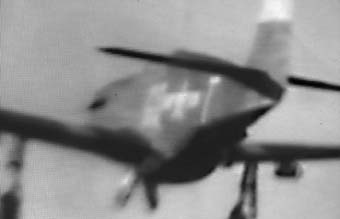
Although of very poor quality but it is (by FLC) the only known photo of 43-12126. This is a still from a film about the 355h FG (from YouTube). Photo via Jarl Svensson

The pilot who shot down Phillips was Unteroffizier Siegfried Rudchinat and he belonged to 10./J.G.11 based at Aalborg, this was Rudchinat´s sixth aerial victory and his first P-51, there would be an additional two P-51´s. Rudchinat´s final tally would end at 12 victories, there´s no place specified for this victory in the rolls. The Germans probably didn´t want to advertise that this occured in Swedish airspace at daytime.
Color Profile by Claes Sundin
Military and police had now come to Svensfält blocks off the crash site. There is not much visible from the crashed plane, there are some twisted fragments lying on the ground and a crater can be seen in the field. Small trails of smoke can be seen and puffs can be heard from the bottom of the pit. Hilding Bengtsson has fetched a horse and carriage and taken the deceased Lt. Phillips to the farm.
The first night in Sweden he gets to spend in the barn at Svensfält. The next day, a Sunday, he is taken to the chapel in Skottorp and later the coming week to Malmoe. All American military that died in Sweden are buried at the Eastern cemetery in Malmoe. When the opportunity eventually is given they are to be buried in American soil, either at war cemeteries in Europe or at home in the United States. Such is the policy. A week atfer the crash Edward Phillips is buried during military honors.
The crashed Mustang is the first of its type to end up in Sweden. At first it is not known what type of aircraft it is lying in the ground, the military tries to salvage the wreck but it´s hard. They´d just rather finish the work. Yngve Jönsson, the farmer of Svensfält, asks if there are more people in the wreckage. No one knows. "Then" Yngve says "you´ll have to dig untill you know, because I do not want a cemetery on my land". After a few days the news from the U.S. arrives. Phillips was alone in his plane, the wreckage not located above ground is laid over an they will remain untouched for 48 years.
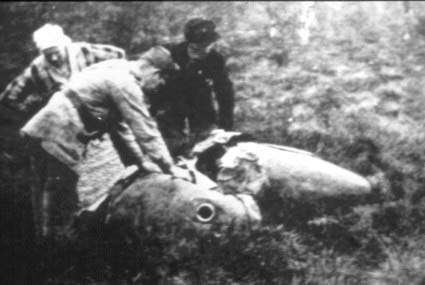
Svensk militär tar hand om bränsletankarna som Phillips släppte medan han försökte undkomma den jagande Messerschmitten. Foto via Jarl Svensson

